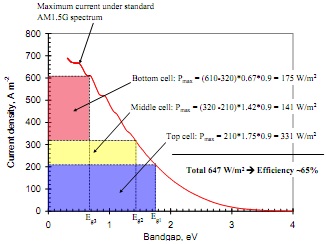Reference no: EM133063998
FEEG6007 Principles of Photovoltaics, Fuel Cells and Batteries - University of Southampton
Problem sheet 1
Part A
Question 1. What are intrinsic, n-type and p-type semiconductors ?
Question 2. Define the efficiency of a solar cell. Under what conditions is it usually measured ?
Question 3. Write down the current-voltage characteristic of an ideal solar cell. How does it differ from the current-voltage characteristic of a diode ?
Question 4. What are the principal electrical parameters that describe the operation of a solar cell? How do they depend on temperature and irradiance ?
Question 5. Using data given in the lecture notes, would you expect the open-circuit voltage of a crystalline silicon cell to be smaller or larger than for an amorphous silicon cell ?
Question 6. What are the principal current losses in a solar cell ?
Question 7. What are the main steps in the manufacture of a crystalline silicon solar cell ?
Question 8. What principal materials are used in the manufacture of thin film solar cells ?
Question 9. What are the main categories of photovoltaic systems ? What typical components do they usually contain ?
Question 10. What are the roles of the following components of photovoltaic systems ?
Inverter Maximum power point tracker
Islanding protection Charge regulator
Low voltage disconnect String (blocking) diode
By-pass diode Sun tracker
Question 11. What are the principal features of the following applications of solar cells:
Solar powered marine signals PV powered irrigation system
Solar power for a satellite Building integrated PV system in Germany
A concentrator PV systems Solar cell for a calculator
Large solar power station Solar array for an isolated holiday home
Part B: True or false ?
1. Cells made from low-bandgap semiconductors usually produce large current.
2. Solar cell can be pictured as a current generator connected in series with a diode
3. The voltage output of a solar cell is directly proportional to the irradiance.
4. The reflectivity of bare silicon is high but decreases to acceptable levels after encapsulating the cells beneath glass.
5. The blocking diode in a stand-alone photovoltaic system is connected in parallel with a string of modules.
6. The photocurrent produced by a photovoltaic generator depends exponentially on the cell temperature.
Part C.
Question 1. The photon spectral flux density in the standard AM1.5 solar spectrum can be approximated by the following function:
φ(E) = 0 (E < a)
φ(E) = k1 (E - a) (b > E ≥a )
φ(E) = k2 (c - E) (c > E ≥ b)
φ(E) = 0 (E ≥ c)
where a = 0.4 eV, b = 0.85 eV, c = 3 eV, k1 = 7. 55x1017 cm-2 s-1 eV-2 and k2 = 1.58x1017 cm-2 s-1 eV-2.
(a) Plot the photon flux density and the corresponding solar spectrum
(b) Plot the graph of the maximum electrical current that can be produced by a 10x10 cm solar cell made from a semiconductor with band gap Eg.
(c) Plot the efficiency of this solar cell as a function of the bandgap Eg assuming that the voltage produced by the cell is equal to (Eg - 0.4), where Eg is in electronvolts and the fill factor is equal to 0.8.
(d) What is the optimum band gap of the solar cell material ?
(e) What is the cell efficiency for this band gap ?
Question 2. Under standard measurement conditions, a solar cell of area 1003 cm has the short-circuit current 3.5A and open-circuit voltage 0.6V. The temperature coefficient of the open-circuit voltage is equal to - 2.3mV/deg C; the short-circuit current can be assumed temperature independent. The fill factor is equal to 0.7 and can be assumed constant. Calculate the cell efficiency in the following situations:
(a) Under standard conditions
(b) Under the irradiance of 0.8 kW/m, with the cell temperature equal to 60°C.
(c) As part of a 50 ×concentrating system, maintaining the cell at 25 C.
Question 3. Using the graph of maximum current that can be produced by a single junction solar cell and a fill factor of 0.9, estimate the efficiency of GaInP / GaAs / Ge triple-junction ce ll with bandgaps of 1.75, 1.42 and 0.67 eV under maximum concentration of sunlight.

Question 4(a) The load factor of a power generator is defined as the ratio between the delivered energy and the energy that would be produced if the generator operated at the rated power for the full period in question. What is the load factor of a photovoltaic generator in terms of the Peak Solar Hours (PSH) ?
(b) A photovoltaic system is to be installed at an isolated farm with daily solar radiation of 5kWh/m2. The generator is to power lighting (350W, used for 4 hours a day) and a water pump (rating 500W, used for 3 hours a day). What size of photovoltaic array (in Wp) and battery (in Wh) would you recommend assuming 6 days of autonomy?